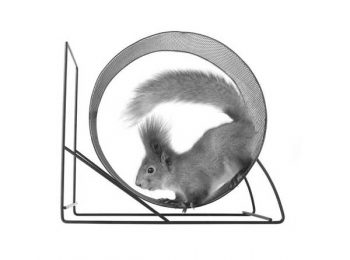What’s the deal with change?
A few weeks ago, a student asked me a very interesting question. It was following a discussion about her frustration with improper Quality Assurance practices where another student, her friends, works. The question she asked was: “What’s the deal with the change you’re always talking about? Is it really necessary in Quality Assurance to always make changes? Can’t we leave something that works as is?”
Well, the short, incomplete answer to most of this question is: that’s right, we must constantly make changes.
The longer and more complete answer is this article, prompted by the conversation.

Status quo
First, I must note that in this particular case we cannot use the phrase “something that works”, for clearly, it doesn’t work. It is completely clear that the practices in place are not as they should be. There is frustration and the feeling of “nothing she can do”. Therefore, evidently, things do not “work”. Therefore, there is really no question whether or not we must change something that doesn’t work.
Second, status quo (maintaining things as they are) is one of the natural enemies of Quality Assurance.
Allow me to elaborate.
Quality Assurance motto, as we all know, is “Constant Improvement”. This is our purpose, is our function, the very reason for our existence.
However, few consider the meaning of this expression. I refer to its meaning regarding change.

It is believed that Einstein once said:
“The definition of insanity is doing the same thing over and over again and expecting a different result”.
The businessman and author Clement Stone said:
“If you always do what you have always done, you will always be where you are right now”.
Then, if we would like to achieve improvement, which would mean a better result, we may clearly not get it by maintaining status quo. In other words, by standing still. We cannot continue to do the same thing over again, seeking a different result.
Thus, the only way to achieve improvement is by changing something in the process whose results we wish to improve. Be that process as it may, in your organization or in life in general.
The conclusion is, therefore, clear. If we cannot improve without change; and if the very reason for our existence is making constant improvement; then we must perform constant change.
Why change that which works?
At this point, someone would wish to say that there surely is no sense in constantly changing what does “work”.
I completely agree. Normally.
However, in all of my professional life, whether as a Quality Assurance Engineer/Manager or as a Consultant, I am yet to discover an organization where everything “works”. Where all processes work as we have intended and produce the best possible results. I have never seen an organization with no processes requiring improvement.
There must be processes in your organization that “work” well, inexpensively and to your satisfaction. Then, is it necessary to make constant changes in them? Of course not. Concentrate on processes, which do not work as smoothly, are costly or whose results are unsatisfactory. Perform small changes anywhere you encounter non-conformance or see the potential for such. You shall never want for work.

Thus said, I must draw your attention to something, which most in our profession do not find evident. It is necessary to sometime make changes even for well-performing processes.
Why do I insist they must be changed? Because:
- anything may be done better and more efficiently;
- the customers want price reductions with respect to other products/processes;
- what “works” fine today may become outdated tomorrow;
- your competitors make progress, technology advances; standing still will not assure your place in the changing world. To retain Quality, you must always strive to be better than you were yesterday, lest your competitors catch up with you.
You may, probably, find more reasons for changing that which “works”.
Another aspect I may introduce for changing what seems to be “working” is leadership. Warren Bennts said:
“The manager accepts the status quo; the leader challenges it”.
Risk management
Good leaders know the truth about the status quo. It may create a feeling of security and stability, still, security and stability are but an illusion. There is no such thing in our world as security, it is a human invention. What exists in life is risk. Life is not an attempt at security, but risk management.
The other side of risk is opportunity. Thus, a Quality Assurance person or manager (leader) who strives for security and stability lives in complete illusion. Moreover, he wastes opportunities by giving them up altogether.
The nature of opportunities is to come and go, they tend to not remain in one place. Giving up an opportunity means it has come and now it’s gone.
A good leader searches for risks and the way to optimize them against opportunities. He wants to grasp the opportunities as they present themselves, and that always involves change.

Change is law of nature
And finally, Nature does not stand still. It is ever-changing, ever-flowing from one moment to the next and from one place to another. The only stillness is death, and even then it only seems that way. Death of one thing gives life to another, it’s another cycle. The meaning of standing still is, therefore, an attempt to live against the Laws of Nature.
Whatever you do, you are an integral part of Nature (however much we would like to kid ourselves that we are not). We cannot, therefore, exist outside its Laws. This makes maintaining the status quo a mere illusion. It will eventually burst, and it shall not be pretty.
Change facilitation
To sum up: however you ponder the question whether change is necessary in Quality Assurance, the answer is yes.
We are not merely the heralds of change or the ambassadors of change. We are the bringers of change, the enablers of change, the facilitators of change. You probably all know that most people resist change. It is up to us, then, to introduce the change and ease it in in such a manner that will allow the people to adopt it willingly on their own. With full cooperation and minimum resistance. Only then may we have real change, without passive or hidden resistance. This is the most difficult, the most amazing and the most compensating part of our job.
Still, in order to accept and embrace your job as change facilitators for the people working in your organization, you must first learn to accept and embrace the necessity of constant change yourselves. To allow and facilitate the change in you.
This post is available also in:
 עברית
עברית
You may also find interesting:
Powered by Contextual Related Posts












